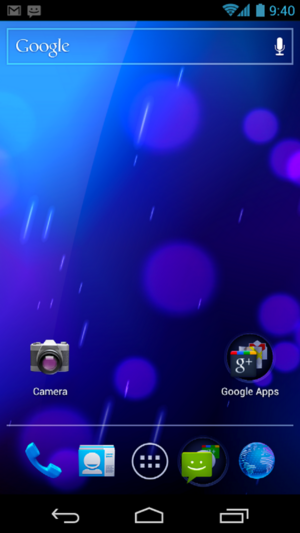 | |
 Default homescreen for Ice Cream Sandwich running on a Galaxy Nexus | |
| Developer | |
|---|---|
| Source model | Open source |
| Released to manufacturing | November 19, 2011 |
| Latest release | 4.0.4 / March 29, 2012 |
| Update method | Various, mostly OTA |
| Kernel type | Linux |
| License | Apache License 2.0 Linux kernel patches under GNU GPL v2[1] |
| Preceded by | Honeycomb |
| Official website | Official website |
Android 4.0 Ice Cream Sandwich is the ninth and most recent major release of the Android operating system for mobile devices such as smartphones and tablet computers. It was officially announced by Google at an event in Hong Kong on October 19, 2011, and the SDK, based on Linux kernel 3.0.1, was released on the same day. The source code was released on November 14, 2011, and the first Ice Cream Sandwich device, the Galaxy Nexus, shipped on November 17, 2011.
The previous version, 3.0 Honeycomb, was released only for tablets, so Ice Cream Sandwich was the first release for smartphones since 2.3 Gingerbread in 2010. It aimed to bring the updated features and 'holo' holographic theme from Honeycomb to smartphones to unify the phone and tablet branches of Android into a single OS again.
Features edit
(Note to self: sources - [2][3][4])
In addition to the holo theme from Honeycomb, Ice Cream Sandwich brought to phones the virtual buttons within the user interface (UI), which are present when the device has no front hardware or capacitive buttons. The interface changes further include a custom-designed Roboto font, and a new launcher with more intuitive folder creation, a persistent search bar, and other miscellaneous improvements.
Blah blah more important new features here.
Numerous features that were previously only available through third party apps or hacks and tweaks were built into Android with this release, including a data monitor to manage cellular internet usage and the ability to take screenshots. Other new features include face unlock, which uses the device's front camera (if present) and face recognition software to only unlock the device in the presence of its owner; and improved OpenGL support for hardware acceleration of the UI.
Changelog edit
| Version | Release date | Features |
|---|---|---|
| 4.0.1 | October 19, 2011 |
|
| 4.0.2 | November 28, 2011 |
|
| 4.0.3 | December 16, 2011[9] |
|
| 4.0.4 | March 29, 2012[11] |
|
Reception edit
Critical reception edit
Ice Cream Sandwich was well received, with reviewers appreciating the much needed updates for smartphones, which hadn't seen a significant update since the previous year's Gingerbread, and for refining and fixing the interface and features introduced to tablets with Honeycomb. Anandtech regarded the holo theme and overhauled user interface as a sign of Android maturing and finding its own style and identity, rather than just being a copy of Apple's iOS.[13] Such comments were widespread, with Techradar praising it as slicker and more intuitive.[14] The ability to take screenshots was considered long overdue.[13]
Blah blah more critical reception here. [1] [2] [3] [4]
Conversely, face unlock was thought to be somewhat gimmicky and unreliable, especially when it was fooled by a photograph shortly after Google stated that it couldn't.[15]
Market adoption edit
Six months after its release, Ice Cream Sandwich had reached only 7.1% of Android devices[16]. This contrasts with the previous smartphone release, Gingerbread, which reached 24% in a similar timespan[17], and rival iOS 5 which reached 38% within a few weeks.[18] The reason for the slow uptake was blamed on Android hardware fragmentation, because the official Google release must be extensively tweaked and modified by device manufacturers to work properly on different chipsets and other hardware, and also the lengthy testing that manufacturers and network operators conduct before updates are released to users.[citation needed] Even hobbyist ROM developers such as the CyanogenMod team, who are usually able to release unofficial updates quickly due to the lack of red tape compared to an official update, had trouble releasing stable ROMs quickly due to the significance of the changes between Ice Cream Sandwich and its predecessor 'Gingerbread.[19]
References edit
- ^ "Licenses". Android Open Source Project. Google. Retrieved 2012-02-20.
- ^ Molen, Brad (October 19, 2011). "Android 4.0 Ice Cream Sandwich now official, includes revamped design, enhancements galore". Engadget. Retrieved October 19, 2011.
- ^ German, Kent (October 18, 2011). "Ice Cream Sandwich adds tons of new features". CNET.
- ^ Velazco, Chris (October 18, 2011). "A Quick Android 4.0 Ice Cream Sandwich Feature Rundown". Tech Crunch.
- ^ Kennemer, Quentyn (October 19, 2011). "Android 4.0 Ice Cream Sandwich has Hardware Acceleration". Phandroid. Retrieved October 19, 2011.
- ^ Lia, Sindre (October 21, 2011). "Android 4 Breaks New Ground (Part 6)". infoSync.
- ^ "Verizon's 4G LTE Galaxy Nexus Gets Pictured, Receives Android 4.0.2 Update". DroidLife. November 28, 2011. Retrieved December 8, 2011.
- ^ "Within 2 Hours of Activation, Your Galaxy Nexus Will Receive an Update". DroidLife. December 15, 2011. Retrieved December 15, 2011.
- ^ "Android 4.0.3 Platform and Updated SDK tools". Android Developers Blog, December 16, 2011. Retrieved January 4, 2012.
- ^ "Android 4.0.3 announced, bringing 'variety of optimizations and bug fixes' to phones and tablets". Engadget. December 16, 2011. Retrieved December 17, 2011.
- ^ "Google announces Android 4.0.4". The Inquirer, March 29, 2012. Retrieved March 31, 2012.
- ^ Google announces 4.0.4 on Google+. March 28, 2012. Retrieved March 31, 2012.
- ^ a b http://www.anandtech.com/show/5310/samsung-galaxy-nexus-ice-cream-sandwich-review/3
- ^ http://www.techradar.com/reviews/pc-mac/software/operating-systems/android-4-0-ice-cream-sandwich-1043150/review/page:7#articleContent
- ^ http://www.theverge.com/2011/11/12/2556893/ice-cream-sandwich-face-unlock-feature-fooled-by-a-photo
- ^ http://news.yahoo.com/android-angst-ice-cream-sandwich-adoption-moving-slowly-175110643.html
- ^ http://www.gsmarena.com/24_percent_of_android_users_now_on_gingerbread-news-2960.php
- ^ http://www.appleinsider.com/articles/11/11/08/ios_5_adoption_on_iphone_nears_38_but_ipod_touch_lags_behind_at_12.html
- ^ http://www.cyanogenmod.com/blog/progress-on-cm9